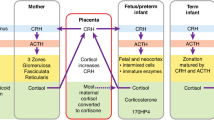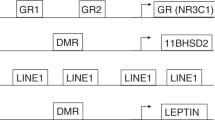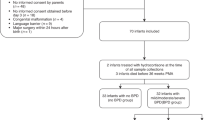Abstract
Summary: The umbilical venous blood concentrations of cortisol, dehydroepiandrosterone sulfate (DHAS), and unconjugated estriol were compared in 54 normal, 37 postterm, and 22 postmature newborns. Pre- and postadrenocorticotropic hormone (ACTH) stimulation levels of serum cort?sol and DHAS were compared in the first 2 to 4 days of life in 19 postterm and 15 postmature infants. Comparison was also made between vaginally and cesarean section delivered postterm and postmature newborns. There were significantly greater cord blood cortisol levels in the post-mature [260 ± 22 ng/ml (±S.E.)], than in the normal (193 ±11 ng/ml) (P ≤0.01) or postterm (193 ± 18 ng/ml) (0.01 ≤P ≤0.05) vaginally delivered infants. There were no significant differences in the mean cord blood DHAS levels in the three groups (normal, 2645 ± 130 ng/ml; postterm, 2323 ± 188 ng/ml; postmature, 2310 ± 224 ng/ml). Cortisol and DHAS responses to ACTH stimulation were the same in the postterm and postmature groups. There was a significantly lower mean umbilical venous unconjugated estriol level in the vaginally delivered postmature group (75 ±11 ng/ml) as compared to values in vaginally delivered postterm (120 ± 14 ng/ml (P = 0.01)] and normal [144 ± 10 ng/ml (P ≤0.002)] newborns. Stressed postmature infants delivered by cesarean section had higher unconjugated estriol levels (83 ± 12 ng/ml) than their unstressed, postterm cesarean section controls [40 ± 9 ng/ml (P ≤0.01)], but levels were still below those from vaginally delivered postterm infants. These findings substantiate normal adrenal function in the postmature fetus and newborn. Lowered umbilical venous unconjugated estriol levels in the postmature infants at birth appear to be a function of limited aromatizing activity of the placenta rather than due to low levels of fetal adrenal-derived neutral steroid substrate.
Speculation: Early in the development of placental insufficiency, placental conversion of fetal-derived netural steroid estrogen precursors is the limiting factor in estrogen production in the feto-placemental unit. whether estrogen precursor production by the fetus also becomes an important factor in decreased feto-placemental unit. Whether estrogen precursor production by the fetus also becomes an important factor in estrogen production as placemental insufficiency progress has not been determined.
Similar content being viewed by others
Log in or create a free account to read this content
Gain free access to this article, as well as selected content from this journal and more on nature.com
or
Author information
Authors and Affiliations
Rights and permissions
About this article
Cite this article
Barnhart, B., Carlson, C. & Reynolds, J. Adrenal Cortical Function in the Postmature Fetus and Newborn Infant. Pediatr Res 14, 1367–1369 (1980). https://doi.org/10.1203/00006450-198012000-00021
Issue date:
DOI: https://doi.org/10.1203/00006450-198012000-00021



